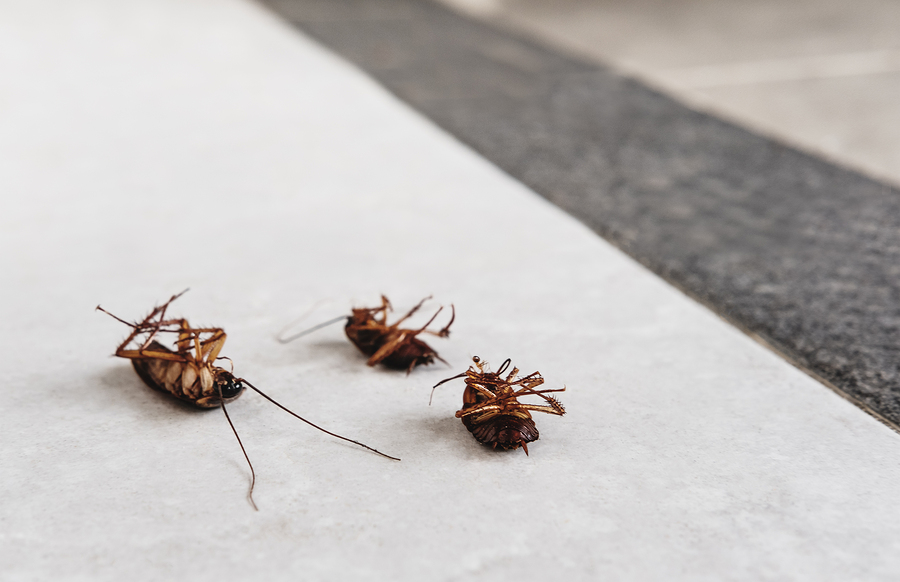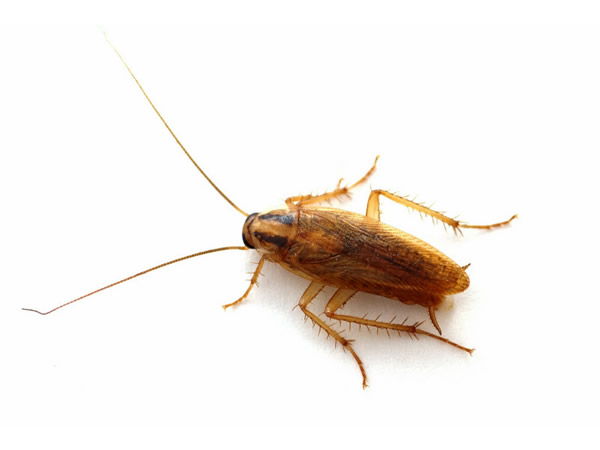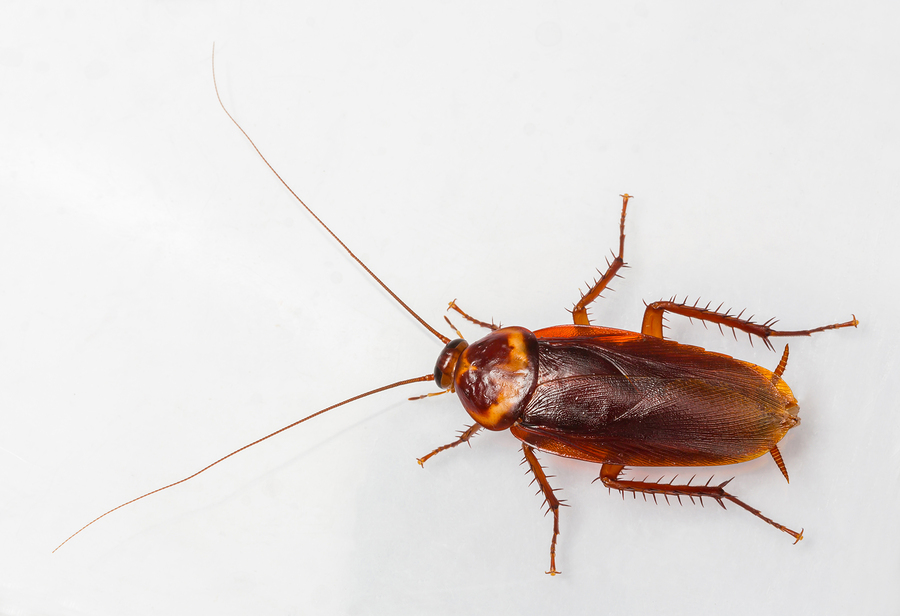
Aug 4, 2017 | Pest Control
Roaches can vary significantly in size and color (some even fly!), so it can be difficult to know what kind of cockroach you’re dealing with. Identification is the first step in roach control since the type of roach will determine the best treatment methods. Here are the 2 most common cockroaches you’ll see in your home and tips for getting rid of and preventing them:
German Cockroaches
German roaches are one of the most common pest nuisances in residential structures, especially common in multi-unit apartment homes. They thrive in filth but even the cleanest homes can be at risk.

What do they look like?
- Brown with 2 longitudinal stripes running down the thorax
- 1/2 to 5/8 inches long
Where do they live?
- German cockroaches will live anywhere humans build heated structures
- Usually found in kitchens in secluded areas (behind and under appliances, in cracks and crevices behind backslashes, at counter edges, behind and under cabinets, in void areas around plumbing, backs of drawer wells)
- Will infest warm areas around appliance motors such as refrigerators and dishwashers
What are the risks?
- German cockroaches will invade your home and leave fecal matter and other debris in and around food and food preparation areas
- Can enter homes when boxes or products are shipped moved from one location to another
- Reproduces at a high rate, completing a life cycle in 30 to 45 days
- Produces 30-48 eggs at a time
- Difficult to get rid of once infested
How do you get rid of them?
- German roaches are most commonly treated inside a home with baits, sprays, or an aerosol product (baits preferred)
- Roaches disperse the bait back into their refuge sites when they ingest it
- Most have a secondary and even a tertiary killing effect, meaning roaches that die in the harborage site from a bait are cannibalized by their fellows, causing additional mortality
- Sprays are applied to surfaces that roaches crawl across or into harborage areas
- Often mixed with insect growth regulators (IGR) will reduce or eliminate egg production and cause mortality in immature forms of the German cockroach
- Aerosols are referred to as crach and crevice treatments; forces roaches out of their harborage sites with a product that excite their nervous system (flushing agent)
- Then sprayed directly with a contact product
- Residual aerosols may be applied into harborage areas and onto surfaces where roaches crawl in the same manner as sprays (commonly sold as over the counter remedies for homeowners, but typically has a short life span)
- Professional pest control is recommended
American Cockroaches (Palmetto Bugs)
American roaches, also known as palmetto bugs or waterbugs, are large, sometimes fly, and usually only come indoors in search of warmth, food or water.

What do they look like?
- Reddish brown in color and have a yellowish margin on their body
- 1.5 to 2 inches in length
- Largest cockroach in the U.S.
Where do they live?
- American cockroaches usually lives in dark, damp areas such as sewers, storm drains, steam tunnels, and outdoors in landscaping and tree holes
- Prefer warm, dark, humid environments in homes such as wall voids, crawl spaces, basements, utility rooms, or attics
- Typically feed on decaying organic matter and a variety of other foods
What are the risks?
- Not commonly seen in homes
- May move indoors during colder months seeking warmer temperatures and food through openings in the foundation
How do you get rid of them?
- Granular baits in attics and crawl spaces
- Dust in attic and crawl spaces
- Perimeter spray treatments
- Perimeter granular bait treatments

Aug 4, 2017 | Pest Control
Roaches can vary significantly in size and color (some even fly!), so it can be difficult to know what kind of cockroach you’re dealing with. Identification is the first step in roach control since the type of roach will determine the best treatment methods. Here are the 2 most common cockroaches you’ll see in your home and tips for getting rid of and preventing them:
German Cockroaches
German roaches are one of the most common pest nuisances in residential structures, especially common in multi-unit apartment homes. They thrive in filth but even the cleanest homes can be at risk.

What do they look like?
- Brown with 2 longitudinal stripes running down the thorax
- 1/2 to 5/8 inches long
Where do they live?
- German cockroaches will live anywhere humans build heated structures
- Usually found in kitchens in secluded areas (behind and under appliances, in cracks and crevices behind backslashes, at counter edges, behind and under cabinets, in void areas around plumbing, backs of drawer wells)
- Will infest warm areas around appliance motors such as refrigerators and dishwashers
What are the risks?
- German cockroaches will invade your home and leave fecal matter and other debris in and around food and food preparation areas
- Can enter homes when boxes or products are shipped moved from one location to another
- Reproduces at a high rate, completing a life cycle in 30 to 45 days
- Produces 30-48 eggs at a time
- Difficult to get rid of once infested
How do you get rid of them?
- German roaches are most commonly treated inside a home with baits, sprays, or an aerosol product (baits preferred)
- Roaches disperse the bait back into their refuge sites when they ingest it
- Most have a secondary and even a tertiary killing effect, meaning roaches that die in the harborage site from a bait are cannibalized by their fellows, causing additional mortality
- Sprays are applied to surfaces that roaches crawl across or into harborage areas
- Often mixed with insect growth regulators (IGR) will reduce or eliminate egg production and cause mortality in immature forms of the German cockroach
- Aerosols are referred to as crach and crevice treatments; forces roaches out of their harborage sites with a product that excite their nervous system (flushing agent)
- Then sprayed directly with a contact product
- Residual aerosols may be applied into harborage areas and onto surfaces where roaches crawl in the same manner as sprays (commonly sold as over the counter remedies for homeowners, but typically has a short life span)
- Professional pest control is recommended
American Cockroaches (Palmetto Bugs)
American roaches, also known as palmetto bugs or waterbugs, are large, sometimes fly, and usually only come indoors in search of warmth, food or water.

What do they look like?
- Reddish brown in color and have a yellowish margin on their body
- 1.5 to 2 inches in length
- Largest cockroach in the U.S.
Where do they live?
- American cockroaches usually lives in dark, damp areas such as sewers, storm drains, steam tunnels, and outdoors in landscaping and tree holes
- Prefer warm, dark, humid environments in homes such as wall voids, crawl spaces, basements, utility rooms, or attics
- Typically feed on decaying organic matter and a variety of other foods
What are the risks?
- Not commonly seen in homes
- May move indoors during colder months seeking warmer temperatures and food through openings in the foundation
How do you get rid of them?
- Granular baits in attics and crawl spaces
- Dust in attic and crawl spaces
- Perimeter spray treatments
- Perimeter granular bait treatments





